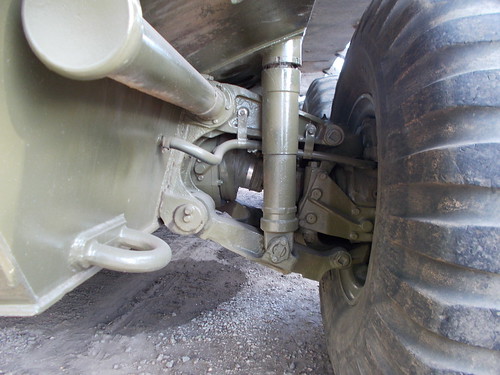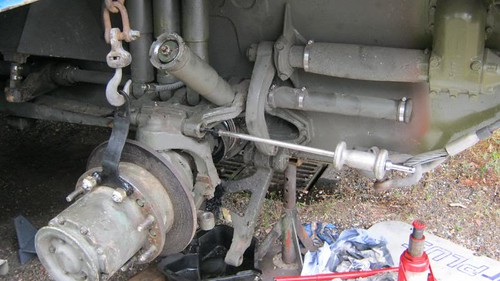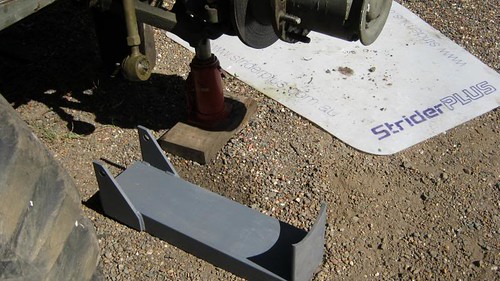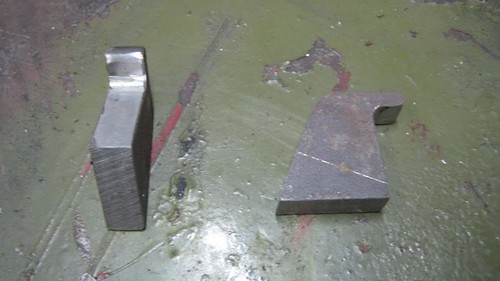
101 Ron
-
Posts
163 -
Joined
-
Last visited
Content Type
Profiles
Forums
Gallery
Blogs
Events
Articles
Store
Downloads
Posts posted by 101 Ron
-
-
I am still using a small supply of original army filters.
my searches for a civil replacement air filter never came up with a direct match.
I think the closest one I found would fit with rework of the filter and the plate that holds it.
Fiat Bambino??????? an long time a go when I looked at this.
Ron
-
The FV 432 was owned by a panel beater who had a little bit of a side business hiring out the vehicle for films and Weddings etc.
A employee of the panel beater was unhappy about things in general.
The employee had seen how the vehicle was started and operated during his normal course of employment.( he had nothing to do with the vehicle as apart of his employment)
The employee came back after work one day and took the vehicle out of a secured and locked premises and cause a police chase and damage..
Another case was a another APC was taken by a ex soldier from a army depot after he cut though security fences etc and again a police chase and much property damage done.
We in Australia are extremely lucky we still have our hobby.
I am not a fan of reenactor groups, but respect what they try to do...……………..it only takes one flip or fruit loop to cause a bad look for our hobby.
The vehicle club I am in is vehicle only and no guns at all and I am happy for it to stay that way as we cannot be seen to be a military organisation...……...but just an old vehicle club.
-
Sorry to hi jack the thread and good luck to another new Stalwart owner......Dan77
I had these photos I have taken of both Saracen and Stalwart rear RHS wheel stations.
It is interesting to note the differences of the ride heights.
Stalwart below
 Stalwart rear tracta joint angle standard ride ht by john smith, on Flickr
Stalwart rear tracta joint angle standard ride ht by john smith, on Flickr
Saracen below
 Saracen rear tracta joint angle by john smith, on Flickr
Saracen rear tracta joint angle by john smith, on Flickr
-
6 hours ago, Richard Farrant said:
Hi Ron,
I am sure we may have discussed this when we met up at Corowa in March. Suspension angle on Stalwarts in comparison with Saracen or Saladin. Both the later vehicles have minimal loads added, so suspension angle is relatively constant. The Stalwart however, is designed for a 5 ton payload, but as we know, practically all of the Stalwarts in private ownership never carry a significant load. so setting the suspension to a similar setting of a Saracen will improve the life of the final drive train and reduce the torque needed to drive them. Years ago when I worked in REME Workshops, I had to do extensive drive line repairs to a Stalwart used by RE for driver training. It was agreed with the unit that we should lower the suspension as they did not carry loads and had been suffering bevel box and tracta joint failures. This solved the problem. I have also done it for a private owner who also had been suffering breakages due to the excessive angle of driveshafts. I did note the heights for each 'axle', (ie Front, Centre, Rear) but it might take a bit of searching to find them.
regards, Richard
Agreed 100 percent and the reason why I placed the words standard suspension height when mentioning the Stalwart.
Ron
-
Reverse any standard Stalwart on full lock on concrete, say though a gate way and the driver will feel the vehicle load up and take alot of energy and power to do the turn.
When you do this sort of move you usually you have someone guiding you because of the poor rearwards visibility. .......the person guiding you can normally see the wheels slip and the tyres leave black scrub marks.
If travelling on hard roads tyre wear is enormous on a standard Stalwart if you are doing any sort of real distances..................the British army could afford it, but I cannot.
Three options for long distance hard road surface driving of a Stalwart.
1......leave as standard and it will chew though tyres,fuel and go poorly to what it could be with the chance of a tracta joint or bevel box going bang if they are not in top condition or have water in them though swimming.
2.......transport the Stalwart on a truck or low loader trailer to where it needs to go and have the expense or paying for this or maintaining another very large vehicle to transport the Stalwart.
3 ..... Go to the trouble of fitting drive disconnects between wheels which will take time and some money to do, but if the transmission has to come out for another problem, then its not much trouble at all.
If the transmission has to come out it would be a great time to fit higher ratio Saracen transfer case gears, but this can be done with some trouble without removing the transfer case from the vehicle.
Everyone has different use patterns for a Stalwart and everyones needs are different.
The Stalwart was designed to follow a tank off road and it does that well.
The next time you look at a Saracen and then a Stalwart with a standard supension ride height, look at the tracta joint angles.
Sarasen is about 15 degrees angle on the rear wheel set and the Stalwart is about 40 degrees unloaded rear wheel set at standard suspension adjustment height.
Stalwart tracta joints work hard.
Ron
-
Like lowfat said the outside splined part of the coupling is machined away by about Three quarters to may be One inch.
The out side of the coupling gets a coller welded onto it so a fork can move the outer part of the coupling backwards or forwards.
A air cylinder is the best way to move the fork and coupling as the vehicle has air already advailable and the air will leave a constant pressure on the coupling to engage or disengage until the splines line up or the load is removed from the coupling.
Further support can be given to the coupling and shaft by making a special coller which replaces one lock nut on the tee bevel box and extends Three quarters the way around the out side of the muff coupling.
Grease nipple to be fitted where possible.
The access needed to do this means fuel, hydraulic tanks out and a lot of work.
The vehicle will go much better on hard surfaces, instead of being a big gustless lump due to wind up.
The effects of the auto locking diff on road are reduced too.
As lowfat pointed out clearences and room around the shafts is poor and will not allow any other affordable drive disconnect options.
The Australian converted Stalwart cruises at 50 mph with out stress with a top speed of over 60 mph with specially cut transfercase case gears.
None of which would be possible without the removal of inter wheel wind up
The Australian Stalwart has no trouble crusing the highways travelling more than 400 miles in a day.
In the UK you have many examples of drive disconnects done to reduce maintance.
Driving on the centre wheels appears to cause no problems and any failure will be confined to the centre tracta joints which is not too big a job to replace.
Removing interwheel wind up allows lubrication to re applied to the tracta joint surfaces just by backing on or off the throttle in most normal driving which is not possible with a standard Stalwart unless you go off road or run over the railway sleepers placed on the road way as done by the British army.
When a standard Stalwart goes down a hard surfaced flat road the tracta joints load up on side only due to differences in tyre diameter and over a period in time the oil between those surfaces squeezes out and the tracta joint becomes dry and picks up metal unless the load though the joint is reversed and the oil is allowed to reapply its self.
Ron
-
Three Known Stalwarts in Australia and only one so far with the disconnects and gear ratio changes.
The shafts as mentioned are super heavy, but to support them requires a split type ,self aligning bearing as the shaft is smaller than the splines on the muff couplings either end.
That bearing is extremely expensive.
Everyone who has done it has used the standard ( modified) muff coupling as the clutch and it also supports the weight of the shaft.
It is not ideal, but it works.
The coupling is usually moved by air, but has also been done by cable.
Plan to fit couplings in time my self using the best ideas from people who have aready done it.
driving a Stalwart on a hard surface goes poorly.
driving a Stalwart on muddy surfaces becomes alive performance wise.
seeing the 60 mph stalwart go and the distances it drives regularly in Australia without trouble , it is a worth while conversion.
Thanks about the comments about my humble site.
https://www.aulro.com/afvb/101-forward-controls-and-variations/118657-ultimate-fc.html
Ron
-
 1
1
-
-
Most of the commercial tourist DUKWs have been greatly changed from the original army design.
diesel motors, only one or two axles driving etc.
one of the main changes appears to be the Higgins pump usually gets removed as it is high maintance and replaced with small plastic electric items.
The Higgins pump runs when the propeller turns and is very high output.
What do these commercial operators do for drive shaft seals/belows, as the old new stock would be cracked or melded with age and hard to find.
The hulls for commercial operations usually have been much changed from standard and constantly repaired and patched.
The roof design of the commercial tourist DUKWs has been noted as a trap for people on sinking DUKWs in the past and nothing appears to have been done.
May be the roof should be made from Styrofoam and float off the vehicle if it sinks and also acts as a life raft.
The original design was very sea worthy
-
 1
1
-
-
Wondering if you guys in the UK are getting the Chinese knock off fluid.
The good stuff is purple in colour.
May add my 101 landrover has had disc brake conversion and re seleeved master cylinder, as have the clutch slave and master cyl……..again no problems.
( I may add 101 Landrovers suffer from transfer of brake fluid from one fluid reservoir to another due to the design of the master cylinder and seals.....the silicone fluid stopped this problem due to its better sealing and lubrication properties)
I have also used the stuff at work on different vehicles and on a 1995 four wheel disc braked defender 130 HCPU all with no problems after directly changing from normal fluid.
The US army I think has the world biggest truck fleet...……...I, don't think the US army would take on silicone fluid if it was problematic or would anyone in the US supply it if there was the slightest chance of brake problems under the US consumer laws and litigation.
Tests have shown alcohol based fluids do not store very well and loose much of the high temp properties after a year and Silicone fluids don't have the same problems.
I wonder if the lower general weather temperatures you get in the UK is a factor as well.
Everyone will always have different experiences I guess.
-
I have been running silicone in my 101 Landrover, US6 Studebaker, modern work van,1960 willys CJ6 jeep for more than 10 years with no problems.
I find I get longer seal life , less corosion of brake parts and better lubrication of parts.
Silicone doesnt strip paint.
Never had a problem with bleeding brakes or a soft pedal.
Alcohol based fluids tend not to lubricate and cause rust.
Most anti silicon negative reports are old ones based in the 1970s when silcone fluids were first beening developed.
The modern purple silcone fluid is made I think 3M or Dupont?...I dont think anyone else makes it regardless of the brand on the bottle besides the Chinese knock offs
A yellow chinese knock off is not worth buying.
If the brake seals are old new stock, or the system is hard to bleed and and silicone fluid is involved it naturally gets the blame.
Any water in the system will bleed though .
The presence of water in normal brake fluid as it asorbed into the fluid reduces its performance and why fluids should be bled though every two years
Any air in the system will bleed though cleanly with normal steady strokes of the brake pedal.
Both normal and silicone fluids should be bled though every two years regardless of useage.
Very happy silicone fluid user in all my vehicles except for the ones designed to use mineral oil in the brakes....ie Saladin, Stalwart ect.
What is not well known, but not recommended is small amounts of normal fluid or silicone fluid together will not cause any problems.
One other advantage of silicone is beening just that little bit thicker and slippery tends to seal wheel cylinder cups better.
The only draw back I found in real life if a wheel cylinder does leak with silicone fluid and the fluid gets on to the brake linings it is a reline job while with normal fluid can be washed off in water....................but the rule books say you shouldnt do this any how.
-
On a stalwart,I fitted a 24 volt electric fuel pump and got the power supply for it from the housing that has the starter and ballast connections in it.
The pump was mounted straight on the engine block where the mechanical pump goes , so the the standard fuel line and fittings where used.
So far no problems.
Vibs from the engine could make the fuel pump fail, but being a 8 cyl B81 which runs very smooth it has not been a problem and I carry a spare pump , just in case and is a easy fit on a Stalwart.
-
A QL is currently being restored in Australia with a GMC 270 engine..........it seems to be a very good fit.
-
It is not cast.
Deep stamped or forged hot from steel bar by the looks of it.
-
-
-
I noticed in the previous photos ....... the door handle, it is showing the reproduction item on my truck.
Two links to US6 Studebaker vids
-
The inner door handle and a lot of hard to get plates and cabin fittings were being reproduced by a man in Queensland Australia.
The door handle was a die cast type much like the civie car items of the time with a plastic knob on the window winder.
Both the winder and inner door handle had felt pad, a chronical spring and plastic covering washer behind the handles much like car practice of the time.
The data plates for the whole vehicle
Under dash vent handle knob
Glove box lid plastic knob
Inner handles and backing plastic washers and felts.
flat springs for the glove box lid...........................................
were all being reproduced to original specs
I can post pics in time.
I do have some where have the details of the man producing these items , but it was a long time ago and I don't know if he still does them or has any thing for sale.
There may be some old new stock in this country, but the inner door handles tended to break often in service.
Ron
-
Try a place that does LPG repairs.
Look at the different LP Gas convertor kits they stock.
LP Gas diaphragms ...the Yellow coloured ones can handle most hydrocarbons.( the black diaphragms cannot )
Cut the fuel pump diaphragm from a LP Gas one .
I have done this and still working fine years later.
-
On my Alvis Stalwart I was having plug troubles mostly though carbon build up.
A sparkplug cleaning machine is ideal, but hard to find these days.
I have a cabinet sand blaster which I used and done the job.
Carby cleaner sometimes will do the job ,but not always.
I have found current Australian fuel is causing issues with the plugs on B series engines.
Just recently on a rally seen a B40 engine foul it's plugs and it was hard to sort out on the side of the road with no spare plugs.
My answer on the Stalwart was electronic ignition and civie protruded nose plugs.
I have not had to take out a sparkplug since and have good starting ,idling and no ignition miss fires.
Civie plugs are cheap.
I couldn't find in Australia the self cleaning protruded nose suspressed military plug for the B series even though the Australian army used them when they first used the series Three Landrovers.
The series Three military Landy were later usually converted to a civie ignition to improve reliability.
-
I don't muck around anymore with the lining up of tracta joints and them moving out of alignment while fitting.
I epoxy glue them lightly.
I don't know what true secret was or how they did hundred of these things quickly on the Alvis production line.
-
it looks possible to me as well .
I've got to remove some very stuck pins first in the wishbones .
I think i'm going to have to fabricate something hydraulic to get them out .
 stalwart hub lifter bracket and suspension pin puller adaptors for slide hammer by john smith, on Flickr
stalwart hub lifter bracket and suspension pin puller adaptors for slide hammer by john smith, on Flickr stalwart suspension pin removal by john smith, on Flickr
stalwart suspension pin removal by john smith, on Flickr stalwart hub removal support frame by john smith, on Flickr
stalwart hub removal support frame by john smith, on Flickr stalwart suspension wedges by john smith, on Flickr
stalwart suspension wedges by john smith, on Flickrhttps://www.aulro.com/afvb/101-forward-controls-and-variations/118657-ultimate-fc-52.html
-
The pin in wishbones come out OK with the use of a slide hammer and a home made UNF bolt to slide hammer adaptor.
Two different size bolt to slide hammer adaptors are needed as different pins have different UNF threads.
-
Take the lead off from the coil box to the distributor at the distributor end and crank over the motor with the ignition on and see if you are getting a spark............from memory it is done just by undoing the hex nut on the shielded high tension lead and pull it out.
If you have spark coming off the lead to earth while cranking the fault must be in the distributor cap and other High tension leads.
If you have no spark you will need to look at the power supply to the ignition coil and check out the ignition points.
The coil is in the sealed housing at the fan end of the motor near the rocker cover.
If I remember correctly a plate is removed some how and inside is a standard lucas ignition coil and you should be able to access the wiring terminals for the coil and see if you have power to it with ignition switch on.
The distributor looks different but is straight forward. ( all from memory again)
To access the points low down either side of the distributor facing downwards are two nuts which clamp the lower half of the distributor together.....loosen these off and you should be able to split the distributor and see the ignition points.
there are two set of points.......do not adjust them as they are set in a special way.............just see if they have low tension power with ignition switch on and they have a gap at the points.(crank over the motor and see if the points spark)
If the motor has not been run in a long time they could just need a clean with a points file just to remove any oxidise coating
-
The added length of wire has been to either get a power supply to run something from the ignition circuit or to by pass everything from the cabin and wiring and Hot wire the ignition system to run the motor by supplying power into that extra wire................you would need to check things out carefully if you decide to do that.
The reason why that junction box is used ....is because of the sealed/suppressed wiring it is the only point of reasonable access to the ignition and starting wiring other than under the cabin dash panel.










Stalwart wanted
in British Vehicles
Posted · Edited by 101 Ron
There are only Two operational Stalwarts in Australia and both are spoken for.
There are a few over in New Zealand, some come up for sale...……..may be cheaper than importing from UK.